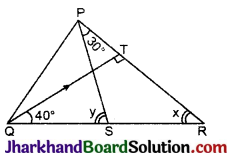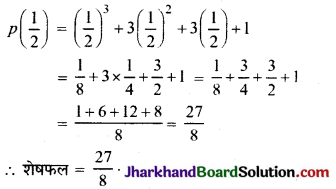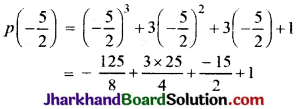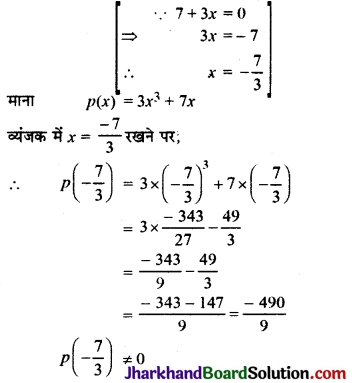Jharkhand Board JAC Class 9 English Solutions Beehive Chapter 10 Kathmandu Textbook Exercise Questions and Answers.
JAC Board Class 9 English Solutions Beehive Chapter 10 Kathmandu
JAC Class 9 English Kathmandu Textbook Questions and Answers
Thinking About the Text
Activity: 1.
1. On the following map mark out the route, which the author thought of but did not take, to Delhi.
नीचे दिये नक्शे पर वह रास्ता दिखाइये जिसके बारे में लेखक ने दिल्ली जाने के लिए सोचा, पर उससे गया नहीं ।
Note- (i) नक्शे को Text Book में देखें ।
Note- (ii) छात्र नक्शे में देखकर स्वयं हल करें ।
2. Find out the possible routes (by rail, road or air) from Kathmandu to New Delhi / Mumbai / Kolkata / Chennai.
काठमाण्डू से नई दिल्ली/मुम्बई / कोलकाता / चेन्नई के लिए (रेल, सड़क या हवाई) जो रास्ते हो सकते हैं, उनका पता लगाइये ।
Note- एटलस की सहायता से छात्र स्वयं करें ।
I. Answer these questions in one or two words or in short phrases:
इन प्रश्नों का उत्तर एक या दो शब्दों अथवा छोटे वाक्यांशों में दीजिये :
Question 1.
Name the two temples the author visited in Kathmandu.
उम दो मन्दिरों के नाम बताइये जिन्हें लेखक ने काठमाण्डू में देखा ।
Answer:
The two temples the author visited in Kathamandu were the Pashupatinath Temple and the Baudhnath Stupa.
लेखक ने काठमाण्डू में दो मन्दिर पशुपतिनाथ मन्दिर और बौद्धनाथ स्तूप को देखा था।
Question 2.
The writer says, “All this I wash down with Coca Cola. ” What does ‘all this’ mean ?
लेखक कहता है, “मैं यह सब कोका कोला के साथ चट कर जाता हूँ ।” ‘यह सब’ से क्या तात्पर्य है ?
Answer:
‘All this’ refers to eating a corn-on-the-cob and a bar of marzipan.
‘यह सब’ यहाँ भुट्टा व बादाम की मिठाई से संबंधित है।
Question 3.
What does Vikram Seth compare to the quills of a porcupine ?
विक्रम सेठ सेही के काँटों से किसकी तुलना करते हैं ?
Answer:
Vikram Seth compares the fifty or sixty flutes protruding in all directions from the pole of a flute seller to the quills of a porcupine.
सभी दिशाओं में बाहर को निकली हुई 50-60 बाँसुरियों की तुलना विक्रम सेठ सेही के काँटो से करता है ।

Question 4.
Name five kinds of flutes.
पाँच प्रकार की बाँसुरियों के नाम बताइये ।
Answer:
Neh, shakuhachi, deep bansuri, breathy flutes and high pitched flutes.
नेह, शाकुहाची, गहरी बाँसुरी, साँस की ध्वनि के साथ बजने वाली बाँसुरियाँ और ऊँचे स्वर में बजने वाली बाँसुरियाँ ।
II. Answer each of the following questions in about 30 words :
निम्नलिखित प्रत्येक प्रश्न का उत्तर लगभग 30 शब्दों में दीजिये :
Question 1.
What difference does the author note between the flute seller and the other hawkers?
लेखक बाँसुरी – विक्रेता व अन्य फेरी वालों के बीच किस अन्तर पर ध्यान देता है ?
Answer:
The author notes that the flute seller does not shout out to sell his wares while the other hawkers do. He is indifferent to his sales while the other hawkers are very keen to sell their items.
लेखक ध्यान देता है कि बाँसुरी विक्रेता चिल्ला-चिल्लाकर अपनी चीजें नहीं बेचता है जबकि अन्य फेरी वाले अपनी चीज़ें बेचने के लिए जोर-जोर से आवाज़ लगाते हैं। वह अपने सामान की बिक्री के प्रति उदासीन है जबकि अन्य फेरी वाले अपनी चीजें बेचने के लिए बहुत इच्छुक हैं ।
Question 2.
What is the belief at Pashupatinath about the end of Kaliyug ?
पशुपतिनाथ मन्दिर में कलियुग के अन्त के विषय में क्या मान्यता है ?
Answer:
There is a belief that when half protruded shrine from the stone platform of river Bagmati comes out fully, the goddess inside will escape. Then the evil period of the Kaliyug will end.
ऐसी मान्यता है कि जब बागमती नदी के किनारे बने पत्थर के चबूतरे से आधा बाहर निकला हुआ पूजा-स्थल पूरा बाहर आ जायेगा तो इसके अन्दर स्थित देवी निकल कर चली जाएगी । तब कलियुग की बुरी अवधि समाप्त हो जायेगी ।
Question 3.
The author has drawn powerful images and pictures. Pick out three examples each of :
लेखक ने शक्तिशाली छवियाँ व चित्र खींचे हैं । निम्नलिखित में से प्रत्येक के तीन उदाहरण चुनियेः
(i) the atmosphere of ‘febrile confusion’ outside the temple of Pashupatinath (for example: some people trying to get the priest’s attention are elbowed aside….) पशुपतिनाथ मन्दिर के बाहर ‘अत्यधिक अस्तव्यस्तता’ का वातावरण (उदाहरण के लिए : पुजारी का ध्यान खींचने की कोशिश करते हुए कुछ लोगों को कोहनी से एक ओर को धकेल दिया जाता है ……. )
Answer:
(a) Priests, hawkers, devotees, tourists, cows, monkeys, pigeons and dogs roam through the grounds.
पुजारी, फेरी वाले, भक्तगण, पर्यटक, गायें, बन्दर, कबूतर और कुत्ते इधर-उधर घूम रहे हैं।
(b) Some Westerners struggle for permission to enter the main gate as only Hindus are allowed.
कुछ पश्चिमी देशों के लोग मुख्य गेट पर प्रवेश की अनुमति पाने के लिए झगड़ रहे हैं क्योंकि केवल हिन्दुओं को ही प्रवेश की अनुमति है।
(c) Two monkeys are fighting and running here and there screaming.
दो बन्दर लड़ रहे हैं और चीखते हुए जहाँ-तहाँ भाग रहे हैं ।
(ii) The things he sees. (जो चीज़ें वह देखता है ।)
Answer:
(a) A sign which proclaims Entrance for the Hindus only. He also saw the Baudhnath Stupa which was ringed by a road.
एक सूचना पट्ट जो घोषणा करता है ‘केवल हिन्दुओं के लिए प्रवेश’ । उसने बौद्धनाथ स्तूप भी देखा जो चारों और एक सड़क से घिरा हुआ था।
(b) A corpse being cremated on the banks of river Bagmati.
बागमती नदी के किनारे एक शव का अन्तिम संस्कार ।

(c) Small shops of Tibetan immigrants near the Buddhist shrine. Besides he saw fruit sellers, flute sellers and hawkers of postcards etc.
बौद्ध मन्दिर के समीप तिब्बती आप्रवासियों की छोटी दुकानें । इसके अतिरिक्त उसने फल विक्रेता और बाँसुरी विक्रेताओं और पोस्टकार्ड की फेरी वालों आदि को भी देखा।
(iii) The sounds he hears.
वे आवाज़ें जो वह सुनता है ।
Answer:
(a) Film songs blare out from the radios.
रेडियो पर बजते फिल्मी गाने बहुत जोर से बजते हैं।
(b) Car horns sound. Bicycle bells ring.
कारों के हॉर्न बजते हैं । साइकिलों की घंटियाँ बजती है।
(c) Vendors shout out their wares. He listens to flute music calling it the most universal and most particular of sounds.
फेरी वाले चिल्ला-चिल्लाकर अपनी चीजें बेचते हैं । वह बाँसुरी की ध्वनि भी सुनता है जिसे वह सबसे अधिक सार्वभौमिक और सबसे अधिक विशिष्ट ध्वनि बताता है।
III. Answer the following questions in about 60 words each:
निम्नलिखित प्रत्येक प्रश्न का उत्तर लगभग 60 शब्दों में दीजिये :
Question 1.
Compare and contrast the atmosphere in and around the Baudhnath shrine with the Pashupatinath temple.
बौद्धनाथ पूजा-स्थल के अन्दर और चारों ओर के वातावरण की पशुपतिनाथ मन्दिर के वातावरण से तुलना कीजिए और अन्तर बताइये |
Answer:
This contrast can be presented as follows:
- The Boudhanath shrine has a sense of stillness spread all around whereas there is an atmosphere of hurried activity at the Pashupatinath temple.
- There are no crowds at the Baudhnath shrine whereas many people, birds and animals are roaming at the Pashupatinath temple.
- The Baudhnath shrine is surrounded by a road whereas river Bagmati flows below the Pashupatinath temple.
- The Baudhnath shrine is a haven of peace whereas different types of noise are present at the Pashupatinath temple.
इस अन्तर को निम्नलिखित प्रकार से प्रस्तुत किया जा सकता है :
- बौद्धनाथ पूजा – स्थल पर चारों ओर शान्ति है जबकि पशुपतिनाथ मन्दिर में जल्दबाजी – भरा वातावरण है ।
- बौद्धनाथ पूजा-स्थल पर बिल्कुल भीड़ नहीं है जबकि पशुपतिनाथ मन्दिर पर बहुत-से लोग, पक्षी और पशु इधर-उधर घूम रहे हैं ।
- बौद्धनाथ पूजा – स्थल के चारों ओर एक सड़क है जबकि पशुपतिनाथ मन्दिर के नीचे बागमती नदी बहती है
- बौद्धनाथ पूजा – स्थल शान्ति की शरणस्थली है जबकि पशुपतिनाथ मन्दिर में अनेक प्रकार का शोर है ।
Question 2.
How does the author describe, Kathmandu’s busiest streets ?
लेखक, काठमाण्डू के सबसे अधिक व्यस्त मार्गों का वर्णन किस प्रकार करता है ?
Answer:
There are small shrines along these narrowest and busiest streets. There are fruit sellers, flute sellers, hawkers etc., who sell their things in these streets. Copper utensils and Nepalese antiques are also sold at the shops. Vendors shout out their wares. Film songs are played on a very high volume from the radios. Car horns sound and bicycle bells ring and stray cows low questioningly at motorcycles.
इन सर्वाधिक सँकरे मार्गों के किनारे-किनारे छोटे-छोटे पूजा-स्थल हैं। फल विक्रेता, बाँसुरी विक्रेता, फेरी वाले आदि सब है जो इन मार्गों अपनी चीज़ें बेचते हैं। दुकानों पर ताँबे के बर्तन और प्राचीन नेपाली वस्तुएँ भी बिकती हैं । फेरी वाले चिल्ला-चिल्ला कर अपनी वस्तुएँ बेचते हैं। रेडियो पर बहुत तेज आवाज़ में फिल्मी गाने बजते रहते हैं । कारों के हॉर्न बजते हैं और साइकिलों की घण्टियाँ बजती रहती हैं और आवारा गायें मोटरसाइकिलों को देखकर कुछ पूछती हुई सी रंभाती रहती हैं ।

Question 3.
“To hear any flute is to be drawn into the commonality of all mankind.” Why does the author say this ? ”
किसी भी बाँसुरी का संगीत सुनना सम्पूर्ण मानवता की एकरूपता में खिंचे चले जाना है . ?” लेखक यह क्यों कहता है ?
Answer:
There are different types of flutes in different countries. Every flute has its own distinct structure. But there is one thing common among them all. It is that the flute music is. the closest in its phrases and sentences to the human voice. Human breath plays it. Thus, its motive force is living breath. As breath needs pause before going on, so does it. That is why, he says that whichever flute he may be hearing, seems to him just close to all mankind.
अलग-अलग देशों में अलग-अलग प्रकार की बाँसुरियाँ हैं । प्रत्येक बाँसुरी की अपनी विशिष्ट संरचना होती है । लेकिन उन सब में एक बात समान है । वह बात यह है कि बाँसुरी के संगीत की तान और वाक्य मानव – ध्वनि के सबसे अधिक निकट हैं । यह मानव की साँस से बजती है । इस प्रकार इसकी प्रेरणादायिनी शक्ति जीती-जागती साँस है। जैसे श्वास को चलते रहने से पहले कुछ रुकने की आवश्यकता होती है ठीक उसी प्रकार इसे भी । इसीलिए वह कहता है कि भले ही वह किसी भी बाँसुरी का संगीत सुने, उसे यह मानवता के निकट लगता है ।
Thinking About Language
I. Read the following sentences carefully to understand the meaning of the italicised phrases. Then match the phrasal verbs in Column A with their meanings in Column B:
नीचे दिये वाक्यों को ध्यान से पढ़कर टेढ़े छपे वाक्यांशों का अर्थ समझिए । फिर कॉलम A में दिये Phrasal Verbs का कॉलम B में दिये उनके अर्थों से मिलान कीजिए :
1. A communal war broke out when the princess was abducted by the neighbouring prince.
2. The cockpit broke off from the plane during the plane crash.
3. The car broke down on the way and we were left stranded in the jungle.
4. The dacoit broke away from the police as they took him to court.
5. The brothers broke up after the death of the father.
6. The thief broke into our house when we were away.
A — B
(i) break out — (a) to come apart due to force
(ii) break off — (b) end a relationship
(iii) break down — (c) break and enter illegally : unlawful trespassing
(iv) break away (from someone) — (d) to start suddenly (usually a fight, a war or a disease)
(v) break up — (e) to escape from someone’s grip
(vi) break into — (f) stop working
Answer:
(i) breakout …………….. (d) to start suddenly ( usually a fight, a war or a disease).
(ii) break off ………………. (a) to come apart due to force
(iii) break down ……………….. (f) stop working
(iv) break away (from someone) ……………… (e) to escape from someone’s grip
(v) breakup ……………….. (b) end a relationship
(vi) break into ………………. (c) break and enter illegally: unlawful trespassing
II. 1. Use the suffixes – ion or -tion to form nouns from the following verbs. Make the necessary changes in the spellings of the words:
Example: proclaim- proclamation
नीचे दिये गये verbs से nouns बनाने के लिए उनमें ion या tion प्रत्यय जोड़िये । शब्दों की वर्तनी में आवश्यक परिवर्तन कीजिए :
उदाहरण : proclaim – proclamation

Answer:
cremation, action, exhaustion, invention, temptation, immigration, direction, meditation, imagination, dislocation, association, dedication.
2. Now fill in the blanks with suitable words from the ones that you have formed.
अब जो शब्द आपने बनाये हैं, उनमें से उपयुक्त शब्दों से रिक्त स्थानों की पूर्ति कीजिए :
(i) Mass literacy was possible only after the …………. of the printing machine.
(ii) Ramesh is unable to tackle the situation as he lacks.
(iii) I could not resist the …………. to open the letter.
(iv) Hard work and …………… are the main keys to success.
(v) The children were almost fainting with …………. after being made to stand in the sun.
Answer:
(i) invention
(ii) imagination
(iii) temptation
(iv) dedication
(v) exhaustion.

III. Punctuation
Use capital letters, full stops, question marks, commas and inverted commas wherever necessary in the following paragraph:
नीचे दिये गये अनुच्छेद में जहाँ भी आवश्यक हो, बड़े अक्षर, पूर्ण विराम, प्रश्नवाचक चिह्न, अर्द्ध विराम और उद्धरण चिह्नों का प्रयोग कीजिए :
an arrogant lion was wandering through the jungle one day he asked the tiger who is stronger than you you O lion replied the tiger who is more fierce than a leopard asked the lion you sir replied the leopard he marched upto an elephant and asked the same question the elephant picked him up in his trunk swung him in the air and threw him down look said the lion there is no need to get mad just because you don’t know the answer
Answer:
An arrogant lion was wandering through the jungle one day. He asked the tiger, “Who is stronger than you?” “You, O lion !”, replied the tiger. “Who is more fierce than a leopard?” asked the lion. “You, sir,” replied the leopard. He marched upto an elephant and asked the same question. The elephant picked him up in his trunk, swung him in the air and threw him down. “Look,” said the lion, “there is no need to get mad just because you don’t know the answer.”
IV. Simple Present Tense
पाठ में आये इन वाक्यों को ध्यान से पढ़िये :
- A fight breaks out between two monkeys.
- Film songs blare out from the radios.
- I wash it down with Coca-Cola.
टेढे शब्दों में छपी verbs, Simple Present Tense में हैं । यहाँ लेखक यह वर्णन कर रहा है कि उसने क्या देखा और सुना परन्तु वह Past Tense के बजाय Present Tense का प्रयोग करता है । Present Tense का इस प्रकार से प्रयोग करके किसी वर्णन या कहानी को अधिक नाटकीय और त्वरित बनाया जा सकता है।
अब नीचे दिये वाक्यों को देखिये :
- A small shrine half protrudes from the stone platform on the riverbank.
- Small shops stand on the outer edge of the Stupa.
Simple Present Tense का प्रयोग उस बात को बताने के लिए किया जाता है जो प्रायः या सामान्यतः सत्य होती है । ऊपर दिये वाक्य तथ्यों का वर्णन करते हैं। सार्वभौमिक सत्य अर्थात सदा सच रहने वाली बात प्रदर्शित करने वाले वाक्यों में भी Simple Present Tense का प्रयोग किया जाता है । उदाहरण के लिए :
- The sun rises in the east.
- The earth revolves round the sun.
Simple Present Tense के प्रयोग से ‘आदत’ प्रकट किये जाने वाले कार्यों के विषय में भी बताया जा सकता है:
- He usually takes a train instead of a bus to work.
- We often get fine drizzles in winter.
everyday, often, seldom, never, every month, generally, usually suf प्रयोग किये जा सकते हैं ।

1. Fill in the blanks with the correct form of the verb in brackets:
कोष्ठकों में दिये verb के सही रूप से रिक्त स्थानों की पूर्ति कीजिए :
(i) The heart is a pump that pumping action …………..(send) the blood circulating through our body. The ……… (take place) when the left ventricle of the heart (contract). This …………. (force) the blood out into the arteries, which…………. (expand) to receive the oncoming blood.
(ii) The African lungfish can live without water for up to four years. During a drought it (dig) a pit and (enclose) itself in a capsule of slime and earth, leaving a
tiny opening for air. The capsule (come) the mud.
(iii) MAHESH : We have to organise a class party for our teacher.
………….. (Do) anyone play an instrument?
VIPUI. : Rohit ………….. (play) the flute.
MAHESH : ………….. (Do) he also act?
VIPUI. : No, he ………….. (compose) music.
MAHESH : That’s wonderful!
Answer:
(i) sends, takes place, contracts, forces, expand.
(ii) digs, encloses, dries, hardens, comes, dissolves, swims
(iii) Does, plays, Does, composes

Speaking
Question 1.
Discuss in class the shrines you have visited or know about. Speak about one of them.
कक्षा में उन धर्मस्थलों के विषय में चर्चा कीजिये जिन्हें आपने देखा हो या जिनके बारे में आप जानते हैं। उनमें से एक के विषय में बोलिये ।
Answer:
There are many shrines in Rajasthan. Some famous shrines among them are Govind Dev temple, Birla temple (Jaipur), Dargah (Ajmer), Brahma temple (Pushkar), Madan Mohan temple (Karauli), Shrinath temple (Nathdwara), Jagdish temple (Udaipur) etc. Last month I visited Shrinath ji temple at Nathdwara.
When I reached its entrance through a narrow street, I saw a big crowd waiting outside for the prayers. The big silver gate of the temple was closed. The devotees were reciting hymns and singing prayers. There were many shops outside. They were selling prasad items, jewellery, costumes, wooden toys and photos of Shrinath ji.
There was a febrile confusion all around. Everyone was busy with his routine work. After some time the gate was opened. The devotees ran towards the door elbowing aside one-another. Finally I had a view of the great idol of Shrinath ji in that great rush.
Question 2.
Imagine you are giving an eyewitness account or a running commentary of one of the following:
Answer:
कल्पना कीजिये कि आप निम्न में से किसी एक पर प्रत्यक्ष विवरण (आँखों देखा हाल ) सुना रहे हैं
(i) a game of football, cricket or hockey, or some sports event
(ii) a parade (e.g. Republic Day) or some other national event
Speak a few sentences narrating what you see and hear. Use the simple present and the present continuous tenses.
For example:
आप जो कुछ देखते या सुनते हैं उनके बारे में कुछ वाक्य बोलिये ।
Simple Present तथा Present continuous tenses का प्रयोग कीजिए । उदाहरण-
- He passes the ball but Ben gets in the way…….
- These brave soldiers guard our frontiers. They display their skills here……….
Answer:
(i) A Running Commentary of Cricket
Friends! Good morning! Today we are going to enjoy a very big match between India and Pakistan. It is a bright sunny day, just a good day for cricket. The Umpire comes on the ground and so the both captains. Oh! good! Indian captain wins the toss and decides to bat. The opening batsmen Sachin and Sehwag enter the field for batting.
The Pak captain arranges the fielding very well. Now, look! the bowler is throwing the first ball of the match. Sachin hits the ball towards the offside boundary. The fielders run after to pick up the ball. But they fail to catch it and the ball crosses the boundary. India gets four runs. The spectators cheer up and applaud Sachin.

(ii) The Republic Day Parade
Friends! I welcome you today on the great occasion of India’s 71st Republic Day Pa- rade at India Gate in Delhi. The President of India is going to unfurl the tricolour in a few moments. The Chief Guest of the parade is the President of Brazil. We welcome and thank him for accepting this honour.
Now the President of India hoists the flag. The army bands play our National Anthem. It fills our hearts with patriotism. Now we can see the troops of Indian army heading the other military forces. They start parade and salute the National Flag. Afterwards other troops are coming such as the Indian Air Force, the Indian Navy, the B.S.F., the C.R.P.F. the I.T.B.P., the N.C.C. Cadets etc. for the same. The display of discipline by troops amazes us very much.
Writing:
Diary entry for a travelogue.
यात्रावृत के लिए दैनन्दिनी में प्रविष्टि ।
I. The text you read is a travelogue where the author, Vikram Seth, talks about his visit to two sacred places in Kathmandu. Imagine that you were with Vikram Seth on his visit to Pashupathinath temple, and you were noting down all that you saw and did there, so that you could write a travelogue later.
जो पाठ आपने पढ़ा है वह एक यात्रावृत है जिसमें लेखक विक्रम सेठ काठमाण्डू में दो पवित्र स्थलों के भ्रमण के विषय में बताते हैं । कल्पना कीजिये कि आप उनके पशुपतिनाथ मन्दिर के भ्रमण के समय उनके साथ थे तथा आपने जो कुछ भी वहाँ देखा तथा किया उसे आप लिख रहे थे जिससे कि आप बाद में एक यात्रावृत लिख सकें ।
Record in point form : बिन्दु रूप में अभिलेखित कीजिये
What you saw when you reached the Pashupatinath temple
(पशुपतिनाथ मन्दिर पर पहुँचने पर जो आपने देखा )
What you saw happening inside the temple
(मन्दिर के अन्दर जो भी कार्य होता हुआ देखा )
What you did when inside the temple
(मन्दिर के अन्दर जो आपने किया )
What you saw outside the temple
(मन्दिर के बाहर जो आपने देखा )

What your impressions are about the place
( उस स्थान के बारे में आपके विचार )
Answer:
13 July 2020, 9:00 a.m. Pashupatinath temple, a sign board ‘Entrance for the Hindus ly’, Febrile confusion.
- Worshippers were offering prayers, elbowing one another and pushing to make their way, to the frent, a princess of the Napalese royal house came to offer prayers, everyone bowed before her.
- Offered prayers and saw other worshippers.
- Saffron-clad Westerners were struggling to enter the temple, a fight took place between two monkeys, saw the
- Bagmati river and the cremation of a corpse. Old offerings were being throwng were in the river.
- It was crowdy and noisy place with the narrowest and busiest streets.
II. Here is your diary entry when you visited Agra. Read the points and try to write a travelogue describing your visit to Agra and the Taj Mahal. You may add more details.
आपने जब आगरा भ्रमण किया उसकी दैनन्दिनी प्रविष्टि यहाँ दी हुई है। बिन्दुओं को पढ़िये और अपने आगरा व ताजमहल भ्रमण का वर्णन करते हुए एक यात्रावृत लिखिए। आप अतिरिक्त विवरण भी जोड़ सकते हैं।
January 2020-rise before dawn-take the Shatabdi Express at 6:15 a.m. from Delhi-meet a newly-married couple on train-talk about Himachal Pradesh-get off the train-enter the once-grand city, Agra-twisted alleys-traffic dense-rickshaws, cars, people-vendors selling religious artifacts, plastic toys, spices and sweets-go to the Taj Mahal-constructed entirely of white marble-magical quality-colour changes with varying of light and shadow-marble with gemstones inside-reflection of the Taj Mahal in the pond-school-children, tourists-tourist guides following people.
Answer:
Visiting Agra and the Taj Mahal
On January 13, 2020, I rose before dawn at about 5:00 a.m. I was in Delhi. After getting fresh I took the Shatabdi Express at 6:15 a.m. I was sitting alone in the compartment and getting bored. Soon a newly-married couple got into the compartment. They belonged to Himachal Pradesh. I started talking with them about Himachal Pradesh.
I came to know a lot about this state from them. At about 9:00 a.m. the train reached Agra platform. I got off the train and entered the once-grand city, Agra. When I began to walk through the streets, I noticed that all eyes were twisted. There was a lot of traffic. It was too difficult to walk through the streets. Rickshaws, cars, buses, bikes, scooters were speeding fast. Everyone was busy with his work.
The vendors were selling religious artifacts, plastic toys, spices and sweets. After some time I went to the Taj Mahal. I purchased a ticket and entered its campus. It is constructed entirely of white marble. It looks as if it had been made with magicalcharms. It has magical quality and depicts the height of Indian architecture in those days. The marble of the Taj Mahal changes with varying of light and shadows.

Inside the monument, as I saw, various gemstones were studded in the marble. There is a pond in front of it. The reflection of the Taj Mahal in the pond looks amazing. I noticed that a great many people had come to visit this monument. There were school-children and other tourists. Tourist guides were following the people offering them to assist them in visiting the monument.
JAC Class 9 English Kathmandu Important Questions and Answers
Short Answer Type Questions
Answer the following questions in about 30 words each:
निम्नलिखित प्रत्येक प्रश्न का उत्तर लगभग 30 शब्दों में दीजिये :
Question 1.
Who are crowding the Pashupatinath temple ?
पशुपतिनाथ मन्दिर में किनकी भीड़ है ?
Answer:
At the Pashupatinath temple, there is an atmosphere of hurried activity. Priests, hawkers, devotees, tourists, cows, monkeys, pigeons and dogs roam there. And thus, the temple is crowded.
पशुपतिनाथ मन्दिर में व्यस्तता – भरा वातावरण है । वहाँ पुजारी, फेरी वाले, भक्तगण, पर्यटक, गायें, बन्दर, कबूतर और कुत्ते इधर-उधर घूमते रहते हैं। और इस प्रकार मन्दिर भीड़ से भरा हुआ है।
Question 2.
Give an example of chaos at the Pashupatinath temple.
पशुपतिनाथ मन्दिर में अस्त-व्यस्तता का एक उदाहरण दीजिए ।
Answer:
There are so many worshippers that some people who are trying to get the priest’s attention are elbowed aside by others. People are pushing one another to get their way to the front.
वहाँ इतने अधिक भक्तगण हैं कि कुछ लोग जो पुजारी का ध्यान खींचने की कोशिश कर रहे हैं उन्हें दूसरे लोगों द्वारा कोहनी मार कर एक तरफ कर दिया जाता है। लोग आगे की ओर आने के लिए एक-दूसरे को धक्का दे रहे हैं ।
Question 3.
Why are some Westerners struggling for permission to enter ?
कुछ पाश्चात्य देशों के लोग प्रवेश की अनुमति के लिए संघर्ष क्यों कर रहे हैं ?
Answer:
Some Westerners are struggling for permission to enter the temple because only Hindus are allowed to enter the temple and the policeman is not convinced that they are Hindus.
पशुपतिनाथ मन्दिर में कुछ पाश्चात्य देशों के लोग अंदर प्रवेश के लिये संघर्ष इसलिए कर रहे हैं क्योंकि केवल हिन्दुओं को मन्दिर में प्रवेश की अनुमति है और पुलिस वाला नहीं मानता है कि वे हिन्दू हैं ।

Question 4.
Why is the Baudhnath Stupa a haven of quietness ?
बौद्धनाथ स्तूप शान्ति की शरणस्थली क्यों है ?
Answer:
The Baudhnath Stupa is a haven of quietness because there are no crowds at the Stupa while the streets around the Stupa are very busy. A sense of stillness pervades near the Stupa.
बौद्धनाथ स्तूप शान्ति की शरणस्थली है क्योंकि वहाँ पर बिल्कुल भीड़ नहीं है जबकि ‘स्तूप के चारों ओर के मार्ग बहुत व्यस्त हैं । स्तूप के पास एक प्रकार की शान्ति छाई है ।
Question 5.
Which things can be bought from the busiest streets of Kathmandu ?
काठमाण्डू के सबसे अधिक व्यस्त मार्गों से कौन-सी चीजें खरीदी जा सकती हैं ?
Answer:
Fruits, flutes, postcards, western cosmetics, film rolls, chocolates, copper utensils and Nepalese antiques can be bought from the busiest streets of Kathmandu.
काठमाण्डू के व्यस्ततम मार्गों से फल, बाँसुरियाँ, पोस्टकार्ड, पाश्चात्य प्रसाधन सामग्री, फिल्मों के रॉल, चॉकलेट, ताँबे के बर्तन और प्राचीन नेपाली वस्तुएँ खरीदी जा सकती हैं ।
Question 6.
Describe the fight between two monkeys at the Pashupatinath temple.
पशुपतिनाथ मन्दिर में दो बन्दरों के बीच लड़ाई का वर्णन कीजिए ।
Ans.
A fight breaks out between two monkeys. One chases the other who jumps onto a Shivalinga. Then he runs shouting around the temples and down to the river Bagmati that flows below.
दो बन्दरों के बीच लड़ाई छिड़ जाती है । एक बन्दर दूसरे बन्दर के पीछे भागता है जो एक शिवलिंग पर कूद जाता है । फिर वह चीखता हुआ मन्दिरों के चारों ओर दौड़ता है और नीचे बागमती नदी की ओर दौड़ता है जो नीचे बहती है।
Question 7.
What are the devotees doing in Pashupatinath temple ?
पशुपतिनाथ के मंदिर में भक्तगण क्या कर रहे हैं ?
Answer:
These devotees are pushing one another to reach the front. They are roaming here and there without any reason. They show some discipline only when a princess of the Nepalese royal house appears there.
ये भक्तगण आगे पहुँचने के लिए एक-दूसरे को धक्का दे रहे हैं। वे बिना किसी कारण के इधर-उधर घूम रहे हैं । वे केवल तभी कुछ अनुशासन दिखाते हैं जब नेपाल के राजसी घराने की एक राजकुमारी वहाँ आती है ।
Question 8.
Describe the scene at the river Bagmati
बागमती नदी के दृश्य का वर्णन कीजिए।
Answer:
On the banks of the river Bagmati, a corpse is being cremated. Washerwomen are washing clothes and children are taking a bath. From a balcony a basket of withered flowers and leaves is dropped into the river.
बागमती नदी के किनारे पर एक शव का दाह संस्कार किया जा रहा है । धोबिनें कपड़े धो रही हैं और बच्चे स्नान कर रहे हैं । एक बालकनी से मुरझाये हुए फूलों और पत्तियों की एक टोकरी नदी में गिराई जाती है।
Question 9.
What does the author say about flute music ?
लेखक बाँसुरी के संगीत के विषय में क्या कहता है. ?
Answer:
The author says that flute music is the most universal as well as most particular. It reminds the author of the commonality of all mankind. He thinks that its motive force too is living breath.
लेखक कहता है कि बाँसुरी का संगीत सबसे अधिक सार्वभौमिक और साथ ही सबसे अधिक विशिष्ट होता है । यह लेखक को सम्पूर्ण मानवता की एकरूपता की याद दिलाता है । वह सोचता है कि इसकी प्रेरणादायिनी शक्ति जीती जागती साँस है।
Question 10.
How is flute music closest to the human voice ?
बाँसुरी का संगीत मानव – ध्वनि के सबसे अधिक निकट कैसे है ?
Answer:
Human breath blows air into the holes of the flute and thus produces music. Flute too needs pause and breathe before it can go on. Thus, flute music is closest to the human voice.
मनुष्य की श्वांस बाँसुरी के छिद्रों में हवा फूँकती है और इस प्रकार संगीत उत्पन्न होता है । बाँसुरी को भी बजते रहने से पहले रुकने और श्वांस लेने की आवश्यकता होती है । इस प्रकार बाँसुरी का संगीत मानव- १ के सबसे अधिक निकट है।

Question 11.
What does the author do in Kathmandu’s busy market ?
काठमाण्डू के व्यस्त बाजार में लेखक क्या करता है ?
Answer:
The author buys a bar of marzipan and a corn-on-the cob rubbed with salt, chilli powder and lemon. He buys a few comics and a ‘Reader’s Digest’. He enjoys them with Coca-Cola and an orange drink.
लेखक बादाम की मिठाई का एक टुकड़ा और नमक, मिर्च और नींबू रगड़ा हुआ एक भुट्टा खरीदता है । वह कुछ कॉमिक्स और एक ‘रीडर्स डाइजेस्ट’ नामक पत्रिका भी खरीदता है । वह कोका कोला और एक सन्तरे से बने पेय के साथ इन सबका आनन्द लेता है ।
Question 12.
How was the flute seller playing a flute ?
बाँसुरी – विक्रेता बाँसुरी कैसे बजा रहा था ?
Answer:
The flute seller was playing a flute slowly, meditatively and without much display. The sound of his flute music rose above the noise of the traffic and the hawkers’ cries.
बाँसुरी – विक्रेता धीमे-धीमे, ध्यानमग्न होकर और बिना बहुत अधिक दिखावा किये बाँसुरी बजा रहा था । उसकी बाँसुरी के संगीत की आवाज़ यातायात के शोर और फेरीवालों की चीख-पुकार से ऊपर उठ रही थी ( सुनाई दें रही थी ) ।
Long Answer Type Questions
Answer the following questions in about 60 words each:
निम्नलिखित प्रत्येक प्रश्न का उत्तर लगभग 60 शब्दों में दीजिये
Question 1.
Describe the scene at Pashupatinath temple.
पशुपतिनाथ मन्दिर के दृश्य का वर्णन कीजिए ।
Or
What kind of atmosphere is there at Pashupatinath temple?
पशुपतिनाथ मन्दिर में कैसा वातावरण है ?
Answer:
At Pashupatinath temple, people, birds and animals are roaming here and there. Worshippers are trying to get the priest’s attention by pushing one another. Hawkers are selling their wares and trying to attract the tourists. There are monkeys and they are fighting and running here and there. At one occasion people look disciplined when they bow at the arrival of a princess of Nepalese royal house. Thus, the atmosphere is full of complete chaos.
पशुपतिनाथ मन्दिर में लोग, पशु व पक्षी इधर-उधर घूम रहे हैं । भक्तगण एक-दूसरे को धक्का देकर पुजारी का ध्यान खींचने की कोशिश कर रहे हैं । फेरीवाले अपने-अपने सामान बेच रहे है और पर्यटकों को अपनी ओर आकर्षित कर रहे हैं। वहाँ पर बंदर है और वे लड़ रहे हैं और इधर-उधर भाग रहे हैं। एक अवसर पर व्यक्ति अनुशासित भी दिखाई देते हैं जब नेपाल के राजघराने की राजकुमारी के आने पर वे उसके सामने झुकते हैं। इस प्रकार वहाँ का सम्पूर्ण वातावरण अस्त-व्यस्तता का है ।
Question 2.
Describe the scene in and around the Baudhnath Stupa.
बौद्धनाथ स्तूप के अन्दर और बाहर के दृश्य का वर्णन कीजिए ।
Answer:
At the Baudhnath Stupa, there is a sense of stillness spread all around. There is a road surrounding this shrine. Small shops are located on the outer edge of this road. Felt bags, Tibetan prints and silver jewellery can be bought here. There are no crowds. The place is very peaceful. It seems to be a safe place of peace in the busy streets around.
बौद्धनाथ स्तूप में सब ओर शान्ति का भाव फैला हुआ है । इस पूजा स्थल के चारों ओर एक सड़क है इस सड़क के बाहरी किनारे पर छोटी-छोटी दुकानें हैं । यहाँ से नमदा ( फेल्ट) के बैग, तिब्बत की छपाई के कपड़े और चाँदी के आभूषण खरीदे जा सकते हैं । यहाँ बिल्कुल भीड़ नहीं है । यह स्थान बहुत शान्त है । चारों ओर के व्यस्त मार्गों के बीच यह शान्ति की एक शरणस्थली लगता है ।

Question 3.
Describe the market place of Kathmandu.
काठमाण्डू के बाजार का वर्णन कीजिए ।
Or
How is Kathmandu vivid, mercenary and religious?
काठमाण्डू सजीव, धनलोलुप और धार्मिक कैसे है ?
Answer:
The market place of Kathmandu is very busy. The streets are very narrow here. Fruit sellers, flute sellers, hawkers of postcards, shops selling Western cosmetics, film rolls and chocolates, copper utensils and Nepalese antiques – they all make it vivid and mercenary. There are small shrines and idols of the gods and goddesses decorated with flowers along the streets. They make this city religious.
काठमाण्डू का बाजार बहुत व्यस्त है । यहाँ के मार्ग सँकरे हैं। फल विक्रेता, बाँसुरी- विक्रेता, फेरी लगाकर पोस्टकार्ड बेचने वाले, पाश्चात्य प्रसाधन-सामग्री, फिल्मों के रॉल और चॉकलेट की दुकानें, ताँबे के बर्तनों और प्राचीन नेपाली वस्तुओं की दुकानें ये सब इसे सजीव और धनलोलुप बनाते हैं । मार्गों के किनारे छोटे-छोटे पूजा-स्थल और फूलों से सजी देवी – देवताओं की मूर्तियाँ हैं । ये इस शहर को धार्मिक बनाती हैं।
Seen Passages
Read the following passages carefully and answer the questions given below them :
निम्नलिखित गद्यांशों को ध्यानपूर्वक पढ़िये तथा उनके नीचे दिये गये प्रश्नों के उत्तर दीजिये:
Passage – 1.
I get a cheap room in the centre of town and sleep for hours. The next morning, with Mr Shah’s son and nephew, I visit the two temples in Kathmandu that are most sacred to Hindus and Buddhists. At Pashupatinath (outside which a sign proclaims ‘Entrance for the Hindus only’) there is an atmosphere of ‘febrile confusion’. Priests, hawkers, devotees, tourists, cows, monkeys, pigeons and dogs roam through the grounds.
We offer a few flowers. There are so many worshippers that some people trying to get the priest’s attention are elbowed aside by others pushing their way to the front. A princess of the Nepalese royal house appears; everyone bows and makes way. By the main gate, a party of saffron-clad Westerners struggle for permission to enter. The policeman is not convinced that they are ‘the Hindus’. (only Hindus are allowed to enter the temple).
A fight breaks out between two monkeys. One chases the other, who jumps onto a Shivalinga, then runs screaming around the temples and down to the river, the holy Bagmati, that flows below. A corpse is being cremated on its banks; washerwomen are at their work and children bathe. From a balcony a basket of flowers and leaves, old offerings now wilted, is dropped into the river. A small shrine half protrudes from the stone platform on the river bank. When it emerges fully, the goddess inside will escape, and the evil period of the Kaliyug will end on earth.
1. In which town does the author stay ?
लेखक किस शहर में ठहरता है ?
2. Which two religions have been mentioned here?
यहाँ किन दो धर्मों का उल्लेख हुआ है ?
3. What is the restriction about entry at Pashupatinath temple?
पशुपतिनाथ मन्दिर में प्रवेश के सम्बन्ध में क्या प्रतिबन्ध है ?
4. Whom does everyone bow to give respect and make way for ?
प्रत्येक व्यक्ति किसको सम्मान देने के लिए झुकता है और रास्ता देता है ?
5. Where does a monkey jump ?
एक बन्दर कहाँ कूद जाता है ?
6. Which river has been mentioned in the passage?
इस गद्यांश में किस नदी का उल्लेख हुआ है ?
7. What type of period is Kaliyug ?
कलियुग किस प्रकार का युग हैं ?

8. What is dropped into the river from a balcony.?
बालकनी से नदी में क्या गिराया जाता है ?
9. Find the word from the passage which is the opposite of ‘expensive.
10. Find the word from the passage which means: ‘withered’
Answer:
1. He stays in Kathmandu.
वह काठमाण्डू में ठहरता है ।
2. Hinduism and Buddhism have been mentioned here.
यहाँ हिन्दू और बौद्ध धर्मों का उल्लेख हुआ है ।
3. Only Hindus are allowed to enter here.
यहाँ केवल हिन्दुओं को प्रवेश की अनुमति है।
4. Everyone bows and makes way for a princess of the Nepalese royal house.
नेपाल के शाही परिवार की एक राजकुमारी के लिए प्रत्येक व्यक्ति झुकता है और रास्ता देता है ।
5. A monkey jumps onto a Shivalinga.
एक बन्दर शिवलिंग पर कूद जाता है ।
6. River Bagmati has been mentioned here.
यहाँ बागमती नदी का उल्लेख हुआ है ।
7. Kaliyug is the period of evil.
कलियुग बुराई का युग है
8. A basket of flowers and leaves, old offerings now wilted are dropped into the river from a balcony.
बालकनी से फूलों और पत्तियों की एक टोकरी जो कि अब मुरझा चुकी पुरानी भेंट है, नदी में गिराई जाती है ।
9. cheap
10. wilted
Passage – 2.
At the Baudhnath Stupa, the Buddhist shrine of Kathmandu, there is, in contrast, a sense of stillness. Its immense white dome is ringed by a road. Small shops stand on its outer edge: many of these are owned by Tibetan immigrants; felt bags, Tibetan prints and silver jewellery can be bought here. There are no crowds : this is a haven of quietness in the busy streets around.
Kathmandu is vivid, mercenary, religious, with small shrines to flower-adorned deities along the narrowest and busiest streets with fruit sellers, flute sellers, hawkers of postcards; shops selling Western cosmetics, film rolls and chocolate; or copper utensils and Nepalese antiques. Film songs blare out from the radios, car horns sound, bicycle bells ring, stray cows low questioningly at motorcycles, vendors shout out their wares.
I indulge myself mindlessly: buy a bar of marzipan, a corn-on-the cob roasted in a charcoal brazier on the pavement (rubbed with salt, chilli powder and lemon): a couple of love story comics and even a Reader’s Digest. All this I wash down with Coca Cola and a nauseating orange drink and feel much the better for it.

1. Which religion does the Baudhnath Stupa belong to ?
बौद्धनाथ स्तूप का सम्बन्ध किस धर्म से है ?
2. Who owns many of the small shops here?
यहाँ स्थित बहुत-सी छोटी-छोटी दुकानें किसकी हैं ?
3. Which place is a haven of quietness?
कौन-सा स्थान शान्ति की शरणस्थली है ?
4. How does Kathmandu seem to the author?
लेखक को काठमाण्डू कैसा लगता है ?
5. What types of streets are there at Kathmandu ?
काठमाण्डू में सड़कें कैसी हैं ?
6. What type of noises does the author hear in Kathmandu ?
लेखक काठमाण्डू में किस प्रकार का शोर सुनता है ?
7. Which books did the author buy from the market of Kathmandu ?
काठमाण्डू के बाजार से लेखक ने कौन-सी पुस्तकें खरीदीं ?
8. What things are sold hear the shrines ?
पूजा स्थलों के पास क्या बिकता है ?
9. Find the word from the passage which is the opposite of ‘widest’.
10. Find the word from the passage which means: ‘surrounded’
Answer:
1. The Baudhnath Stupa belongs to Buddhism
बौद्धनाथ स्तूप का सम्बन्ध बौद्ध धर्म से है ।
2. The small shops belong to Tibetan immigrants.
छोटी दुकानें तिब्बत से आये आप्रवासियों की हैं।
3. The Baudhnath Stupa is a haven of quietness.
बौद्धनाथ स्तूप शान्ति की शरणस्थली है ।
4. The author finds Kathmandu vivid, mercenary and religious place.
लेखक को काठमाण्डू सजीव, धनलोलुप और धार्मिक स्थल लगता है ।
5. There are the narrowest and busiest streets. near the shrines of Kathmandu.
काठमाण्डू में पूजा स्थलों के पास सबसे संकरी और सबसे व्यस्त सड़कें हैं ।
6. He hears the noises of film songs, car horns, bicycle bells, lowing of cows and shouting of vendors etc.
लेखक वहाँ फिल्मी गानों, कारों के हॉर्न, साइकिल की घंटियों, गायों के रँभाने और फेरी वालों के चिल्लाने आदि की आवाज सुनता है ।
7. He purchased a couple of love story comics and a ‘Reader’s Digest’ from there.
उसने वहाँ से प्रेमकथाओं पर आधारित कॉमिक्स तथा ‘रीडर्स डाइजेस्ट’ खरीदे ।
8. Fruits, flutes, postcards, Western cosmetics, copper utensils and Nepalese antiques are sold there.
वहाँ फल, बाँसुरियाँ, पोस्टकार्ड, पाश्चात्य प्रसाधन के सामान, तांबे के बर्तन और नेपाली प्राचीन वस्तुयें बिकती हैं ।
9. narrowest
10. ringed
Passage – 3.
I look at the flute seller standing in a corner of the square near the hotel. In his hand is a pole with an attachment at the top from which fifty or sixty bansuris protrude in all directions, like the quills of a porcupine. They are of bamboo : there are cross-flutes and recorders. From time to time he stands the pole on the ground, selects a flute and plays for a few minutes. The sound rises clearly above the noise of the traffic and the hawkers’ cries. He plays slowly, meditatively without excessive display. He does not shout out his wares.
Occasionally he makes a sale, but in a curiously offhanded way as if this were incidental to his enterprise. Sometimes he breaks off playing to talk to the fruit seller. I imagine that this has been the pattern of his life for years. I find it difficult to tear myself away from the square. Flute music always does this to me: it is at once the most universal and most particular of sounds.

There is no culture that does not have its flute-the reed neh, the recorder, the Japanese shakuhachi, the deep bansuri of Hindustani classical music, the clear or breathy flutes of South America, the high-pitched Chinese flutes. Each has its specific fingering and compass. It weaves its own associations. Yet to hear any flute is, it seems to me, to be drawn into the commonality of all mankind, to be moved by music closest in its phrases and sentences to the human voice. Its motive force too is living breath: it too needs to pause and breathe before it can go on.
1. Where is the flute seller standing ?
बाँसुरी- विक्रेता कहाँ खड़ा हुआ है ?
2. What are the flutes made of ?
बाँसुरियाँ किसकी बनी हुई हैं ?
3. Why does the flute seller stop playing sometimes?
बाँसुरी – विक्रेता कभी-कभी बाँसुरी बजाना क्यों रोक देता है ?
4. What forces the author to stay at that very place ?
क्या बात लेखक को वहीं रुकने के लिए बाध्य कर देती है ?
5. Which is the most universal and particular sound ?
सबसे अधिक सार्वभौमिक और विशिष्ट ध्वनि कौन-सी है ?
6. Where does the flute music draw the author to ?
बाँसुरी का संगीत लेखक को कहाँ खींच ले जाता है ?
7. What is the motive force of flute music ?
बाँसुरी के संगीत की प्रेरणादायिनी शक्ति क्या है ?
8. What are the qualities of flutes of different nations ?
विभिन्न राष्ट्रों की बाँसुरियों की विशेषताएँ क्या हैं ?
9. Find the word from the passage which is the opposite of – ‘purchase’
10. Find the word from the passage which means : ‘stop for a while’
Answer:
1. He is standing in a corner of the square near the hotel.
वह होटल के निकट चौराहे के एक कोने में खड़ा हुआ है ।
2. They are made of bamboo
बाँसुरियाँ बाँस की बनी हुई हैं ।
3. Sometimes the flute seller stops playing flute to talk to the fruit seller.
विक्रेता से बात करने के लिए बाँसुरी बजाना रोक देता है । कभी-कभी बाँसुरी बेचने वाला फल –
4. Flute music forces him to stay at that very place.
बाँसुरी का संगीत उसे वहीं रुकने के लिए बाध्य कर देता है ।
5. It is the sound of flute music.
यह बाँसुरी के संगीत की ध्वनि है ।
6. The flute music draws him into the commonality of all mankind.
बाँसुरी की संगीत उसे सम्पूर्ण मानवता की एकरूपता में खींच ले जाता है ।
7. Its motive force is living breath.
इसकी प्रेरणादायिनी शक्ति जीती-जागती साँस है ।

8. The qualities of flutes of different nations are different. Each has its specific fingering and compass.
विभिन्न राष्ट्रों की बाँसुरियों की विभिन्न विशेषताएँ हैं । प्रत्येक बाँसुरी का अपना विशिष्ट उँगली रखने का तरीका और फैलाव होता है ।
9. sale
10. pause
Kathmandu Summary and Translation in Hindi
About The Lesson
‘काठमाण्डू’ पाठ ‘दिव्य सरोवर’ नामक एक यात्रावृत्त से उद्धृत है जिससें विक्रम सेठ ने चीन से तिब्बत तथा दिव्य सरोवर से हिमालय तक की यात्रा के दौरान जो देखा उसका चिन्तन किया व अनुभव किया एवं उसके बारे में वर्णन किया है।
Before You Read ( पढ़ने से पूर्व )
क्या आपको यात्रा करना पसन्द है ? लेखक विक्रम सेठ को यात्रा करने में बड़ा आनन्द आता है । अपनी पुस्तक ‘Heaven Lake’ में वे चीन से तिब्बत और नेपाल के रास्ते, भारत की एक लम्बी यात्रा का वर्णन करते हैं । क्या आपने अजमेर शरीफ, मदुरई, साँची, वाराणसी, सारनाथ या हेलिबिड जैसे स्थानों के बारे में सुना है ? क्या आप इनके जैसे कुछ अन्य स्थानों के नाम बता सकते हैं ? आपके शहर के किसी पवित्र स्थान के चारों ओर का वातावरण कैसा लगता है ? विक्रम सेठ के काठमाण्डू के वर्णन को पढ़ते समय इस विषय में सोचिए
Word-Meanings And Hindi Translation
1. I get a cheap …………… and Buddhists. (Page 127)
Word-Meanings: get (गेट) = to acquire, लेना, प्राप्त करना । cheap (चीप) = of low cost, सस्ता । centre (सेन्टर) = the middle point, बीच, केन्द्र | nephew (नेफ्यू) = son of a brother or sister, भतीजा । sacred (सैक्रिड) = holy, पवित्र ।
हिन्दी अनुवाद – मैं शहर के बीचों-बीच एक संस्ता कमरा लेता हूँ और घण्टों सोता हूँ। अगली सुबह श्रीमान् शाह के बेटे और भतीजे के साथ मैं काठमाण्डू के दो मन्दिर घूमने जाता हूँ जो हिन्दुओं और बौद्धों के लिए सबसे अधिक पवित्र हैं।
2. At Pashupatinath ………….. enter the temples
Word Meanings: sigh (साइन) = (here) notice board, सूचना पट्ट | proclaims ( प्रॅक्लेम्ज़) makes known publicly or officially, जानकारी देता है, घोषणा करता है । entrance ( एन्ट्रन्स) the gate where you go into a place, प्रवेश | atmosphere ( एट्ॉस्फिअर ) = वातावरण। of febrile confusion (ऑव फीब्राइल कन्फ्यूश्ज़न ) = hurried activity, complete chaos, अस्त व्यस्तता, हड़बड़ी । priests ( प्रीस्ट्स) person who performs religious ceremonies, पुजारी | hawkers (हॉकर्ज़) = persons who sell goods by going from place to place, फेरी वाले । devotees (डेवॅटीज़ ) = worshippers, उपासक, भक्तगण । tourists (टूरिस्ट्स) = persons who visit a place for pleasure, पर्यटकों।

roam (रोम) = wander, इधर-उधर घूमना । offer (ऑफर) = present in the name of God, अर्पित करना । worshippers (वॅर्शिप : ज) = devotees, भक्तगण, उपासक। attention ( अटेन्शन) = notice, ध्यान । elbowed ( एल्बोड) = pushed aside with the elbow, कोहनी से धक्का दिया जाना । aside (असाइड) = to one side, एक ओर को । pushing (पुशिंग) = using force to move somebody, धक्का देकर । way (वे) = रास्ता । front (फ्रन्ट) = forward, आगे, सामने।
royal (रॉयल) = belonging to the king of a country, राजसी, शाही | appears (अपिअर्ज़) = is seen, दिखाई देती है । bows (बाउज़) = bends, झुकता है । party (पार्टि) = group, समूह । saffron (सैफ़रन) = केसरिया रंग । clad ( क्लैड) = wearing, पहने हुए | Westerners (वेस्टर्नर्ज) = people belonging to Western countries, पाश्चात्य देशों के लोग । struggle (स्ट्रगल) = make forceful or violent efforts, संघर्ष करना | permission (पॅ:मिशन) = the action of officially allowing someone, अनुमति, आज्ञा । convinced (कन्विन्स्ट) = completely sure about something, आश्वस्त, विश्वास हुआ।
हिन्दी अनुवाद – पशुपतिनाथ मन्दिर ( जिसके बाहर लगा एक सूचना पट्ट घोषणा करता है ‘प्रवेश केवल हिन्दुओं के लिए’) पर अत्यधिक अस्त-व्यस्तता का वातावरण है । पुजारी, फेरी वाले, भक्तगण, पर्यटक, गायें, बन्दर, कबूतर और कुत्ते पूरे मैदान में इधर-उधर घूमते रहते हैं । हम कुछ पुष्प अर्पित करते हैं । वहाँ इतने अधिक उपासक हैं कि कुछ लोग जो पुजारी का ध्यान खींचने की कोशिश कर रहे हैं, उन्हें दूसरे लोगों द्वारा कोहनी मारकर एक ओर कर दिया जाता है जो धक्का देकर आगे आने के लिए रास्ता बनाने में लगे हुए हैं।
नेपाल के राजसी (शाही) घराने की एक राजकुमारी दिखाई देती है; प्रत्येक व्यक्ति ( उसके सम्मान में ) झुकता है और रास्ता देता है । मुख्य द्वार के पास केसरिया रंग के वस्त्र पहने हुए पाश्चात्य देशों के लोगों का एक समूह प्रवेश की अनुमति के लिए संघर्ष कर रहा है। पुलिस का सिपाही विश्वास नहीं करता है कि वे हिन्दू हैं (केवल हिन्दुओं को ही मन्दिर में प्रवेश की अनुमति है )।
2. A fight breaks out …………. end on earth. (Pages 127-128)
Word Meanings: breaks out (ब्रेक्स आउट) = starts, प्रारम्भ हो जाती है। chases (चेसिज़) = runs after, पीछा करता है । jumps ( जम्प्स) = hops, कूद जाता है । screaming (स्क्रीमिंग) = crying, चीखता हुआ। holy (होलि ) = pious, पवित्र । flows (फ़्लोज़) = a steady and contionuous movement of something, बहती है । below (बिलो) = to a lower position, नीचे | corpse (कॉ: प्स् ) = dead body, शव, लाश । cremated (क्रिमेटिड ) = last rites performed, अन्तिम संस्कार किया जाना ।
banks (बैंक्स) = the sides of a river, किनारे | washerwomen (वॉश: विमिन) = women whose occupation is washing clothes, धोबिनें । bathe (बेद) = to take a bath, स्नान करना । basket (बास्केट) = a container for earrying things, टोकरी | leaves (लीव्ज़) = green parts of a plant / tree, पत्तियाँ । offerings (ऑफरिंग्ज़) = things offered in the name of God, भेंटें। wilted (विल्टिड) = withered, मुरझाई हुई । dropped (ड्रॉप्ट) = thrown, गिरा दिया जाना ।
shrine (थाईन),, = a place of worship, पूजा-स्थल । protrudes (प्रॅट्रड्ज़) = emerges, उभरा हुआ है। platform (प्लेटफॉम) = चबूतरा । emerges (इमर्जिज़) = comes out, बोहर आ जाती है । escape (इस्केप ) = manage to get away from a place; to get free, निकल भागना, निकल जाना। evil ( ईवल) = bad, बुरा । period (पीरिअड ) = time from, अवधि ।
हिन्दी अनुवाद – दो बन्दरों के बीच लड़ाई प्रारम्भ हो जाती है । एक बन्दर दूसरे का पीछा करता है, जो एक शिवलिंग पर कूद जाता है, फिर चीखता हुआ मन्दिरों के चारों ओर नीचे पवित्र बागमती नदी की ओर भागता है जो नीचे बहती है । इसके किनारे पर एक शव का अन्तिम संस्कार किया जा रहा है; धोबिनें अपना कार्य (कपड़े धोना ) कर रही हैं और बच्चे स्नान कर रहे हैं ।
एक बालकनी (छज्जे) से फूलों और पत्तियों की एक टोकरी जिसमें मुरझाई हुई पुरानी भेंटें हैं, नदी में गिराई जाती है । नदी के किनारे बने पत्थर के चबूतरे से एक छोटा-सा पूजा स्थल आधा बाहर की ओर उभरा हुआ है । (ऐसी मान्यता है कि ) जब यह पूरा बाहर आ जायेगा तो अन्दर रहने वाली देवी निकलकर चली जाएगी और पृथ्वी पर कलियुग की बुरी अवधि समाप्त हो जायेगी ।

3. At the Baudhnath …………… busy streets around. (Page 129)
Word-Meanings: Buddhist (gfat) belonging to the followers of Buddha, बौद्धों का। contrast (कॅन्ट्रास्ट) = to be clearly different when compared तुलना करने पर भिन्न होना। sense (सेन्स) feeling, भान्न | stillness ( स्टिलनस) = peace, शान्ति। immense (इमेन्स) = very big, बहुत बड़ा, विशालकाय । dome (डोम) = a round roof on a building, गुम्बद | ringed (रिंग्ड) = surrounded, चारों ओर से घिरा हुआ। stand (स्टैंड) = (here) are located, स्थित हैं ।
outer ( आउटर) = external, बाहरी । edge ( एज) = end, किनारा। owned (ओन्ड) = belonged to, से सम्बन्धित हैं, की हैं । immigrants ( इम्मिग्रेन्ट्स) = people who come from another place, आप्रवासी । felt ( फेल्ट) = a kind of cloth made from wool pressed tightly, नमदा, ऊन आदि को दबाकर बनाया गया एक प्रकार का कपड़ा । crowds ( क्राउड्ज़) = large number of people in one place, भीड़-भाड़ | haven (हेवन) a safe place, सुरक्षित स्थान, विश्रामस्थल | quiteness (क्वाइटनंस) = peace, शान्ति | busy (बिज़ी) = full of crowd and noise, भीड़-भाड़ और शोरगुल से भरी । streets ( स्ट्रीट्स) = a road in a town, village on city, मार्ग | around (अराउण्ड ) = in all directions, चारों ओर।
हिन्दी अनुवाद- काठमाण्डू में बौद्धों के पूजा-स्थल बौद्धनाथ स्तूप पर पशुपतिनाथ मन्दिर की तुलना में अलग ही शान्ति का भाव है । इसका विशालकाय सफेद गुम्बद चारों ओर से एक सड़क से घिरा हुआ है । इसके बाहरी किनारे पर छोटी दुकानें स्थित हैं, इनमें से बहुत-सी दुकानें तिब्बती आप्रवासियों की हैं : यहाँ आप्रवासियों से नमदा (एक प्रकार के कपड़े के बैग, तिब्बती प्रिंट और चाँदी के आभूषण खरीदे जा सकते हैं। यहाँ कोई भीड़-भाड़ नहीं है: चारों ओर की भीड़-भाड़ व शोरगुल भरे मार्गों के बीच यह शान्ति का एक सुरक्षित स्थान है अर्थात् यहाँ पूर्ण शान्ति है|
4. Kathmandu is vivid, ………………. the better for it. (Pages 129-130)
Word Meanings: vivid ( विविड ) = lifelike, सजीव | mercenary ( मर्सीनरि) = working simply for money, जिस काम में केवल पैसा कमाने की बात हो, धनलोलुप । religious (रिलीजस ) = having belief in religion, धार्मिक | shrines (थाइन्ज़ ) places of worship, पूजा-स्थलों । adorned (एडॉर्न्ंड) decorated, सुसज्जित | deities (डेअटीज़ ) gods, देवताओं | along ( अलांग) = on the sides, किनारों पर । narrowest (नैरोएस्ट ) = very short distance, सबसे अधिक सँकरे | busiest ( बिजिएस्ट ) = having a lot of work, सबसे अधिक व्यस्त । streets ( स्ट्रीट्स) =a road in a town, village on city, मार्ग | flute ( फ्लूट) a musical instrument like a pipe, बाँसुरी |
Western (वेस्टर्न) belonging to the west, पाश्चात्य । cosmetics (कॉस्मेटिक्स) = substances that you use to look more attractive, प्रसाधन सामग्री । copper (कॉपर) ताँबा । utensils (यूटेन्सल्ज़) = pots, बर्तन | antiques (एन्टिक्स) = old items of great value, प्राचीन वस्तुएँ | blare out (ब्लेअर आउट) = are played on high volume, बहुत तेज आवाज करते हैं। sound ( साउण्ड ) = make noise, जोर से बजते हैं । stray (स्ट्रे) = not pet, आवारा । low (लो) = sound of a cow, गायें भाती हैं।
questioningly (क्वेश्चनिंग्लि) = as though asking something, मानो कुछ पूछती हुई । vendors (वेण्डर्ज़) = people selling things on the roadside, फेरी वाले विक्रेता । shout out (शाउट आउट) things, चीजें । indulge (इन्डल्ज) : shouting and selling, चिल्लाकर बेचते हैं । wares ( वेअर्ज़) involve, शामिल हो जाना | mindlessly (माइण्डलस्लि) = without thinking, बिना सोचे-समझे|

bar (बार) piece, टुकडा, I marzipan (माज़िपैन) = a sweet made with grated almonds, बादाम को कसकर बनाई हुई एक मिठाई । corn-on-the-cob (कॉर्न-ऑन-द- कॉब) = maize when cooked and eaten straight from the cob, भुट्टा 1 roasted (रोस्टिड) = baked, भुना हुआ । charcoal brazier (चारकोल ब्रेज़ियर) = open stove of coals, लकड़ी के कोयले की अँगीठी । pavement (पेवमण्ट ) = a path with a hard surface, सड़क के किनारे की पटरी | rubbed (रब्ड) रगड़ा हुआ।
chilli powder (चिली पाउडर) = पिसी मिर्च । lemon (लेमन) yellow sour juice fruit, नींबू । a couple of (अ कॅपल ऑव ) a few, कुछेक । wash down (वॉश डाउन) = to drink something after, or at the same time as eating something, किसी चीज़ को खाते हुए पीना । nauseating (नॉज़िएटिंग) = sickening, जी खराब करने वाला, जी मिचलाने वाला।
हिन्दी अनुवाद – सबसे अधिक सँकरे और सबसे अधिक व्यस्त मार्गों के किनारे छोटे-छोटे पूजा-स्थलों से लेकर फूलों से सुसज्जित देवताओं तक; फल विक्रेताओं, बाँसुरी विक्रेताओं, पोस्टकार्ड्स के फेरी वालों, पाश्चात्य प्रसाधन सामग्री बेचने वाली दुकानों, फिल्मों के रॉल और चॉकलेट तक; या ताँबे के बर्तनों और प्राचीन नेपाली वस्तुओं से भरपूर काठमाण्डू सजीव, धनलोलुप और धार्मिक स्थल है । रेडियो पर बजते हुए फिल्मी गाने बहुत तेज आवाज में (कर्कस आवाज में.) बजते हैं, कारों के हार्न बजते हैं, साइकिलों की घण्टियाँ बजती हैं, आवारा गायें मोटरसाइकिलों को देखकर मानो कुछ पूछती हुई सी रँभाती हैं और फेरी वाले चिल्ला-चिल्लाकर अपना सामान बेचते हैं।
मैं बिना सोचे-समझे (इस सब में ) शामिल हो जाता हूँ : बादाम की मिठाई का एक टुकड़ा खरीदता हूँ, सड़क के किनारे लकड़ी के कोयले की अँगीठी पर भुना हुआ (नमक, पिसी मिर्च व नींबू रगड़ा हुआ) एक भुट्टा खरीदता हूँ, कुछेक प्रेमकथाओं पर आधारित कॉमिक्स और यहाँ तक कि एक ‘रीडर्स डाइजेस्ट’ भी खरीदता हूँ । यह सब मैं कोका कोला और जी खराब करने वाले संतरे से बने पेय के साथ चट कर जाता हूँ और इस सबके लिए बहुत अधिक अच्छा महसूस करता हूँ।
5. I consider what …………. tomorrow’s flight. (Page 130)
Word-Meanings: consider (कंसिडर) = think, विचार करता हूँ । route (रूट) = way, मार्ग, रास्ता। propelled (प्रॅपेल्ड) = moved, pushed, प्रेरित । enthusiasm (इन्थ्यूजिएज़्म) = zeal, उत्साह, जोश। per se ( पर से) = by itself, स्वयं, अपने आप ही । sail up ( सेल अप) = travel on water, जलमार्ग से यात्रा करना । जिसे exhausted (इग्जॉस्टिड) = tired, थका हुआ । homesick. (होमसिक) = missing one’s home, गृहासक्त, घर की याद सता रही हो । move (मूव) = 80, जाओ । directly ( डिरेक्ट्ल) = straight, सीधे । towards ( ट्वार्ट्ज़) = in the direction of somebody, की ओर । flight (फ्लाइट) = the action of flying through air, उड़ान
हिन्दी अनुवाद – मैं विचार करता हूँ कि घर वापिस जाने के लिए मुझे कौन-सा रास्ता चुनना चाहिए। यदि मैं यात्रा करने के लिए ही उत्साहित रहा होता तो मैं बस तथा रेलगाड़ी से पटना जाता, फिर गंगा में जलमार्ग से यात्रा करता हुआ बनारस से इलाहाबाद और फिर यमुना में जलमार्ग से यात्रा करता हुआ आगरा से दिल्ली पहुँचता । लेकिन मैं बहुत अधिक थका हुआ हूँ, गृहासक्त हूँ अर्थात् मुझे घर की बहुत याद सता रही है; आज अगस्त का आखिरी दिन है । मैं अपने आप से कहता हूँ कि घर चलो और सीधे घर की ओर चलो। मैं नेपाल की एक एयरलाइन्स के कार्यालय में प्रवेश करता हूँ और अगले दिन की उड़ान का एक टिकट खरीद लेता हूँ।

6. I look at the………….. his life for years. (Page 130)
Word-Meanings: standing (स्टैंडिंग) = खड़े हुआ | square (स्क्वेअर) = an open space, चौराहा । pole (पोल) = a long bamboo stick, लट्ठा | attachment ( अटैचमण्ट ) = something joined, उपकरण । protrude (प्रॅटूड) = stick out from a surface, बाहर निकली हुई। recorder (रिकॉर्ड) = a type of musical instrument, (बाँसुरी के समान बजाया जाने वाला) बच्चों का संगीत यंत्र | directions ( डिरेक्शन्ज़) = दिशाएँ । quills (क्विल्ज़) = long, thin, sharp points on the body of a pocupine, सेही के काँटे।
porcupine (पॉर्क्युपाइन) = an animal covered with long thin sharp parts, एक जंतु जिसके शरीर पर पतले नुकीले कांटे से लगे होते हैं जो किसी प्राणी के आक्रमण के समय ऊपर खड़े हो जाते हैं, सेही । bamboo (बैम्बू) = a tall tropical plant, बाँस । from time to time (फ्राम टाइम टु टाइम) = sometimes, थोड़ी-थोड़ी देर में । stands (स्टैण्ड्ज़) = gets positioned, खड़ा कर देता है, टिका देता है ।
selects (सिलेक्ट्स) = chooses, picks up, चुनता है, लेता है | plays ( प्लेज़) = makes music with a musical instrument, बजाता है । rises ( राइज़िज़ ) : उठती हैं । meditatively (मेडिटेटिव्लि ) = thoughtfully, ध्यानमग्न होकर । excessive (इक्सेसिव) much, अत्यधिक | display (डिस्प्ले ) = show, दिखावा wares (वेअर्ज़) = things, चीजें । occasionally (ॲकेश्ज़नलि) = now and then, कभी-कभी । curiously (क्युरिअस्ल ) = strangely, अजीब ।
offhanded ( ऑफ़ हैण्डिड ) = not showing much interest, उदासीन | way (वे) = manner, तरीका । as if (ऐज़ इफ) = as though, जैसे कि । incidental (इन्सिडेण्टल ) = something that happens very rarely, कभी-कभी होने वाली घटना। enterprise (एण्टॅ: प्राइज़) = business, व्यापार, कार्य । breaks off (ब्रेक्स ऑफ़ ) = stops, रोक देता है । imagine (इमेजिन ) = to form a picture or idea in mind, कल्पना करता हूँ | pattern (पैटर्न) way, तरीका।
हिन्दी अनुवाद – मैं होटल के निकट चौराहे के एक कोने में खड़े हुए बाँसुरी – विक्रेता को देखता हूँ। उसके हाथ में एक लट्ठा है जिसके ऊपर लगे उपकरण से पचास-साठ बाँसुरियाँ सेही के काँटों की भाँति सब दिशाओं में बाहर निकली हुई हैं । वे बाँस की बनी हुई हैं : उनमें क्रॉस वाली बाँसुरियाँ और बच्चों के संगीत यंत्र भी हैं । थोड़ी-थोड़ी देर में वह बाँस को जमीन पर टिका देता है, एक बाँसुरी छाँटता है और कुछ मिनट के लिए बजाता है । वह आवाज़ स्पष्ट रूप से यातायात के शोर और फेरीवालों की तेज़ आवाज़ों से ऊपर उठती है (सुनाई देती है ) ।
वह इसे धीमे- धीमे ध्यानमग्न होकर और बिना अत्यधिक दिखावा किये बजाता है । वह अपनी चीजें चिल्ला-चिल्लाकर नहीं बेचता है । वह कभी-कभी ही अपनी चीजें बेचता है अर्थात् हर वक्त नहीं लेकिन एक अजीब उदासीन तरीके से बेचता है, जैसे कि उसके व्यापार के लिए यह कभी-कभी होने वाली घटना है । कभी-कभी वह फल विक्रेता से बात करने के लिए (बाँसुरी) बजाना रोक देता है । मैं कल्पना करता हूँ कि वर्षों से यही उसके जीवन का तरीका रहा है।

7. I find it difficult ………… it can go on. (Pages 130-131 )
Word Meanings: find (फाइण्ड ) = discover, पाता हूँ tear away (टिअर अवे) = move away, अलग होना । at once ( एट वन्स) = at the same time, एक साथ, एक ही समय पर । universal (यूनिवर्सल) found everywhere, सार्वभौमिक | particular (पॅ: टिक्यलर) = belonging to one person, ‘व्यक्तिगत, विशिष्ट | culture (कल्चर) the customs, ideas, beliefs, etc. of a particular society, संस्कृति । reed (रीड) = a tall plant like grass, सरकंडा, नरकुल । classical ( क्लैसिकल) = widely accepted and used for long time, शास्त्रीय । breathy (ब्रीदि) = speaking or singing with a noticeable sound of breathing, साँस की ध्वनि के साथ गाते हुए |
high pitched ( हाई पिच्ट ) = in high tone, ऊँचे स्वर वाली | specific (स्पेसिफिक) = distinct, विशिष्ट । fingering (फिंगरिंग) = touching something with fingers, उँगली से छूना । compass (कॅम्पास) = range, फैलाव । weaves ( वीव्ज़) = form by interlacing long threads, बुनती है । associa- tions (एसोसिएशन्ज़) = (here) musical combination, स्वर – संगति | yet (पेट) = still, फिर भी । seems (सीम्ज़) = looks, लगता है, प्रतीत होता है । to be drawn (टु बी ड्रॉन) = to be pulled out, खिंचे चले जाना।
commonality(कॉमनलिटि) = = quality of being one and the same, एकरूपता । mankind (मैनकाइण्ड ) humanity, मानवता । to be moved (टु बी मूव्ड) = stirred, द्रवित हो जाना । closest (क्लोज़ेस्ट) = very near, सबसे निकट । phrases (फ्रेज़िज़ ) groups of words that are used together, वाक्यांशों, तानों । human (ह्यूमन) = connected with people, मानवीय | motive (मोटिव) = inspiring, प्रेरणादायिनी । force ( फोर्स) power, शक्ति । living breath (लिविंग ब्रेथ ) = breath full of life, जीती-जागती साँस । (पॉज़) pause रुकना । breathe (ब्रीद) = inwhale and exhale, साँस लेना । go on ( गो ऑन) = carry on, जारी रहना. ( यहाँ) बजाते रहना।
हिन्दी अनुवाद – मुझे उस चौराहे से दूर होना (जाना) कठिन लगता है । बाँसुरी के संगीत से हमेशा मेरे साथ ऐसा होता है : यह एक समय पर होने वाली सबसे अधिक सार्वभौमिक और सबसे अधिक विशिष्ट ध्वनि होती है । ऐसी कोई संस्कृति नहीं है जिसकी अपनी बाँसुरी नहीं है सरकंडे की नेह, रिकॉर्डर, जापान की शाकुहाची, हिन्दुस्तानी शास्त्रीय संगीत की गहरी बाँसुरी, दक्षिणी अमरीका की स्पष्ट या साँस के साथ धीमी बजने वाली बाँसुरियाँ, चीन की ऊँचे स्वर वाली बाँसुरियाँ । प्रत्येक व्यक्ति का (बाँसुरी पर) उँगली रखने का अपना विशिष्ट तरीका और फैलाव होता है ।
प्रत्येक बाँसुरी अपनी स्वयं की स्वर संगति बुनती है। फिर भी, मुझे ऐसा लगता हैं कि किसी भी बाँसुरी को सुनना, सम्पूर्ण मानवता की एकरूपता में खिंचे चले जाना है, मानव – ध्वनि के सबसे अधिक निकट तानों और वाक्यों वाले संगीत से द्रवित होना है । इसकी प्रेरणादायिनी शक्ति जीती-जागती साँस है : इसे भी जारी रखने ( बजाते रहने) से पहले रुकने और साँस लेने की आवश्यकता होती है।
8. That I can be ………… significance I now do. (Page 131)
Word Meanings: affected (अफ़ेक्टिड ) = influenced, प्रभावित । a few (अ फ़्यू) = some, कुछ। familiar (फमिलिअर) = Well-known, जानी-पहचानी, सुपरिचित । phrases (फ्रेज़िज़) = a groups of words that are used together, पदों । surprises (स: प्राइज़िज़ ) = astonishes, आश्चर्यचकित करता है । previous (प्रीविअस) = former, पहले के । occasions (ॲकेश्ज़न्ज़) = chances, अवसर | returned (रिटर्न्स) = came back, वापिस लौटा | absence ( एबसन्स) अनुपस्थिति |
abroad (अब्रॉड) = out of one’s native country, विदेश में | hardly (हाड्लि) = not commonly, मुश्किल से ही । noticed (नोटिस्ट) = paid attention to, ध्यान दिया । details ( डीटेल्ज़) = minute descriptions, छोटी-छोटी बातें 1 certainly (स: टन्लि ) = for sure, निश्चित रूप से । invested (इन्वेस्टिड) = spent time, energy, effort that you thought useful, ध्यान दिया। significance (सिग्निफिकन्स) = importance, महत्व।

हिन्दी अनुवाद – पहले तो मुझे इस बात पर आश्चर्य होता है कि मैं बाँसुरी पर कुछ सुपरिचित पदों (वाक्यांशों) से इतना प्रभावित हो सकता हूँ, क्योंकि पहले के अवसरों पर जब मैं लम्बे समय तक विदेश में रहने के बाद घर लौटा हूँ, मैंने इतनी छोटी-छोटी बातों पर मुश्किल से ही ध्यान दिया है और निश्चित रूप से मैंने उनको इतना महत्व नहीं दिया है जितना कि मैं अब देता हूँ ।
![]()

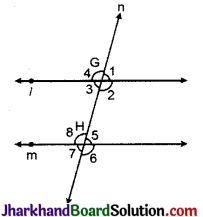
![]()
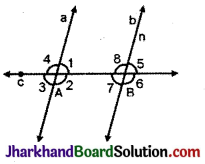
![]()

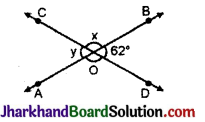
![]()
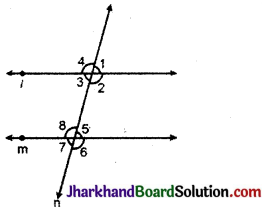
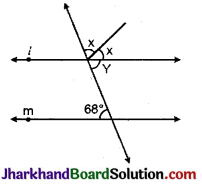
![]()

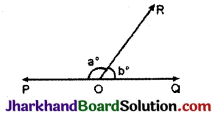


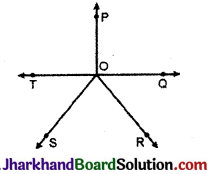
![]()
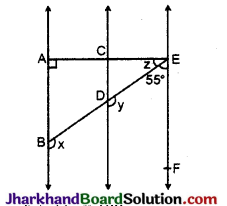
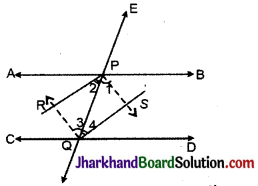
![]()


![]()
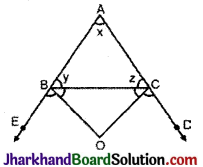
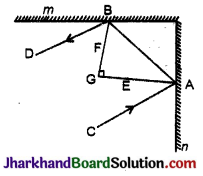
![]()
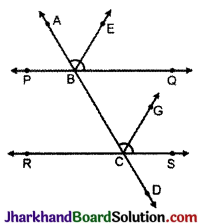
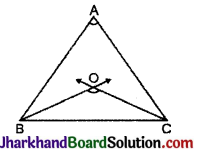
![]()
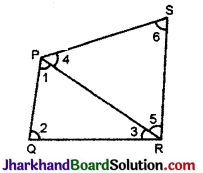
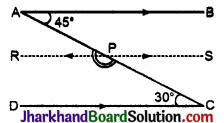
![]()
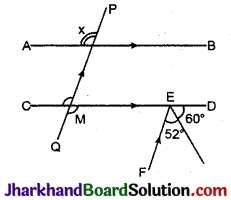

![]()
